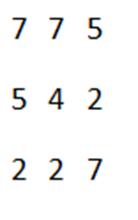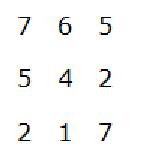However,if you feel your students are curious and ready enough to explore that, we can go down that road a little,
in this little optional diversion:
Optional Diversion: The dominant 7th chord
(This is one of those opportunities to introduce some theory as it is used-it should take about 15 minutes and requires only pencil
and paper; a Fiddlewidget, if your students have them, will make it go a little faster but is not necessary.)
Dominant 7th chords are variations based upon the 5 chord as defined by the Nashville Numbers system.
The word
"dominant" implies the 5th scale degree. Our example tune is in the key of G, so the dominant (5) chord is a D major chord.
Thinking in terms of the D scale, the D major chord is 1-3-5 or d, f# and a.
Thinking in terms of the G scale, the D major (5) chord is 5-7-2 or d, f#, and a. So these are two ways of
thinking your way to the same chord, just like we mentioned in Activity 5.
So now that we've found the dominant chord, to get the dominant 7th we just add a fourth note to it.
That note is the flatted 7th scale degree in the 5 (D) scale, which is a c natural.
If you are thinking in the G scale, using the 5-7-2 for the dominant, you'd add the 4th scale degree of THAT scale,
also a c natural.
Either method of thinking will lead you to the same place. It's like your having both a roadmap AND a GPS device; you can
use whichever method is most convenient and it's good to know them both.
Activity, for this diversion:
Write out the notes of the D major scale, and circle the 1st, 3rd ad 5th scale degrees.
Write out the notes of the G major scale and circle the 5th, 7th and 2nd scale degrees. Both methods should give you the
same notes, d, f# and a.
Now get the Fiddlewidget tool, if you have one and use that to find the same chord; set it to the key of D and notice
the 1,3, and 5 notes highlighted. Now set it at the key of G and notice where the 2nd, 5th and 7th scale
degrees line up. Mark them on the window with a dry erase marker if you want. You'll have the same d, f# and a
notes that you had before, and you'll also instantly see the closest, easiest way to get from the 1 chord (G)
to the 5 (D), no matter where you are on the instrument.
Now we can leave this little diversion and get back to a couple ways to "fix" this close harmony situation, if you
don't want to just leave it alone as a dominant 7th chord.
cleaning up the rough spots?continued
Getting back to our "problem" area in Buffalo Gals, let's look at some other "fixes".
Opening the harmony
If you are looking for something else, other than just leaving it alone as a dominant 7th, you could change the tenor part slightly,
leaving that second note on the 7 instead of moving down to the 5. This configuration would look like this:
 | That would leave the 5 tone unplayed in that second chord, above
the 4 in the melody. |
Leaving "holes" in the harmony or chords like this is called
open harmony. It adds to the range required for instruments or voices to hit, but
it can sound nice, too. It happens a lot in church and other choral music.
Parallel harmony
Another possibility we might try is called parallel harmony; it lets all the parts move to follow the melody
in the same direction. You can think of it as moving through a series of chord changes to fit with whatever
the melody line happens to be.
Suppose when that melody goes 5-4-2, we let the tenor drop from 7-6-5 and the baritone go from 2-1-7.
That would look like this:
 | What happens in this case is that middle chord becomes a quick 4 chord
(4-1-6, remember?) |
So the chord progression, instead of staying in the 5 chord, becomes 5-4-5, moving from the 5 to a quick 4 and back
to the 5. It's a little more inconvenient to play, but might be just what you want. Besides, it gives the
guitar player a chance to show off a little.
Another modification of this approach would be to let the baritone part stay on the 2, instead of dropping to
the 1 on that middle note. That would change the middle chord to an A minor (2 minor) chord instead of a 4.
(There are a ton of references available to give students a look at different chord types, expressed in scale
degrees. I put some of them at
the "chords" page . A good chord book for guitar, mandolin,
etc would have these and more).
Assessment:
Ask students to describe the concepts of parallel harmony and open harmony. Do this in regular conversational English,
telling how they can be used to modify harmony lines, instead of just rote-learning some sterile definition.
Look for other "problem" areas in our Buffalo Gals harmony, and suggest some ways to modify it.
The first full measure in my example has a 6 in the lead over a 3 in the baritone where the underlying chord
is a 1; that might be changed to let the baritone follow the lead with a 4 instead of a 3 (parallel harmony,
resulting in a quick 4 chord instead of that 6 minor).

Just one note, the 5th note in that baritone line, gives a completely different sound.
The 5th full measure has a 1 in the tenor over a 7 in the lead. This is too close for my ear, and I think
it sounds better to leave the tenor on the 3. It also has a 5 in the baritone below a 6 in the lead; this
happens twice. My inclination is to move those 5's down to a 4, or maybe even a 3. A 4 would give you a quick
4 chord, and a 3 would result in a 6 minor. Neither sounds really wrong to me, but the 6m is a little strange.
 The point is, even though this is a very simple tune, most people have to try
things out first in order to find what they like best.
The point is, even though this is a very simple tune, most people have to try
things out first in order to find what they like best.
OK, that's enough about harmony, other than several hundred hours of practice. Now we'll get to taking this
tune and ornamenting it with some homemade licks.



 Just one note, the 5th note in that baritone line, gives a completely different sound.
The 5th full measure has a 1 in the tenor over a 7 in the lead. This is too close for my ear, and I think
it sounds better to leave the tenor on the 3. It also has a 5 in the baritone below a 6 in the lead; this
happens twice. My inclination is to move those 5's down to a 4, or maybe even a 3. A 4 would give you a quick
4 chord, and a 3 would result in a 6 minor. Neither sounds really wrong to me, but the 6m is a little strange.
Just one note, the 5th note in that baritone line, gives a completely different sound.
The 5th full measure has a 1 in the tenor over a 7 in the lead. This is too close for my ear, and I think
it sounds better to leave the tenor on the 3. It also has a 5 in the baritone below a 6 in the lead; this
happens twice. My inclination is to move those 5's down to a 4, or maybe even a 3. A 4 would give you a quick
4 chord, and a 3 would result in a 6 minor. Neither sounds really wrong to me, but the 6m is a little strange.
 The point is, even though this is a very simple tune, most people have to try
things out first in order to find what they like best.
OK, that's enough about harmony, other than several hundred hours of practice. Now we'll get to taking this
tune and ornamenting it with some homemade licks.
The point is, even though this is a very simple tune, most people have to try
things out first in order to find what they like best.
OK, that's enough about harmony, other than several hundred hours of practice. Now we'll get to taking this
tune and ornamenting it with some homemade licks.